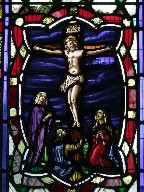| |
|
Not
far from the outskirts of Hadleigh you reach
Lower Layham at the end of a long straight road.
The church presents itself broadside on, and the
road goes circuitously around the churchyard, the
ghost of an ancient track surviving in modern
form. The churchyard is fronted by gorgeous iron
railings, 19th century survivals that weren't
vandalised during the Second World War. Most iron
railings then were cut down, obstensibly to be
turned into Spitfires, but perhaps it was really
to help the English feel that they were doing
their bit.
St
Andrew has little left that is medieval about it,
but this is not necessarily a bad thing. It is a
lovely example of a church that was well cared
for both before and during the 19th century
Anglican revival. The 18th century red brick
tower is simple and seemly, with a late 19th
century rebuilding of the parapet in the Suffolk
crenellated style. The external walls of nave and chancel reveal 14th century
origins, but all the window traceries were also
replaced by the Victorians.
| The south
porch is surprisingly small and
perfunctory, but you enter a church which
is at once homely and elegant. There is a
feeling of it being much more spacious
than it actually is. The one major
medieval survival is the font, a fine example of
the 13th century Purbeck Marble genre
seated on a 19th Century base and
columns. It is a little unusual in one
respect, because instead of being square
or octagonal it is hexagonal. There
are other medieval survivals, including piscinas in both nave and chancel, but the main
impression is of the late 19th and early
20th centuries. Most overwhelming of all
is the elaborate reredos, which is
absolutely gorgeous, and full of High
Church power; Christ is seated in
majesty, flanked by Andrew and John, and
censing angels. Gables, pinnacles and
niches rise above it, and the glass
beyond is equally good. It is as fine an
example as you'll find in rural Suffolk
of the triumphalism of the Anglo-catholic
movement. That movement has moved
on, its tide receded, but at Layham it
made its mark, and it is a good one.
|
|
 |
|
|
|

